ETH News
All stories that have been tagged with Electrical engineering
Tiny component for record-breaking bandwidth
News

A modulator developed by researchers from ETH Zurich has broken the terahertz mark. The ultrafast component efficiently transmits large volumes of data into the fibre-optic network in a short space of time.
Innovative battery design: more energy and less environmental impact
News
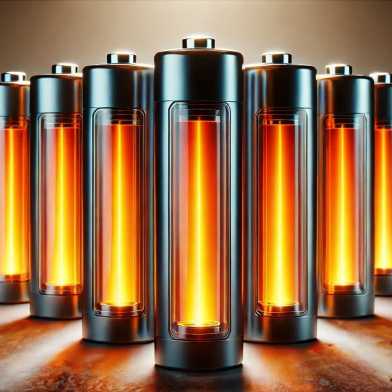
A new electrolyte design for lithium metal batteries could significantly boost the range of electric vehicles. Researchers at ETH Zurich have radically reduced the amount of environmentally harmful fluorine required to stabilise these batteries.
Gold membrane coaxes secrets out of surfaces
News
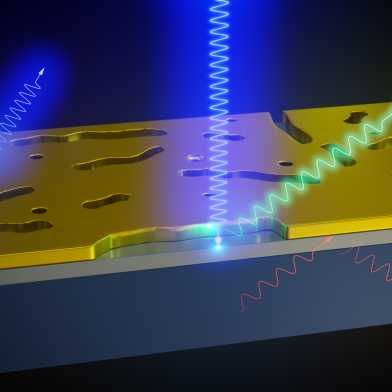
Using a special wafer-thin gold membrane, ETH researchers have made it significantly easier to study surfaces. The membrane makes it possible to measure properties of surfaces that are inaccessible to conventional methods.
Researchers outsmarted EasyRide function on Swiss travel app
News

Experiments by ETH Zurich computer security researchers showed that smartphones can be manipulated to allow the owner to ride Swiss trains for free. The researchers also highlighted ways of curbing such misuse.
ETH Zurich spin-offs develop high performance batteries
- News
- Homepage
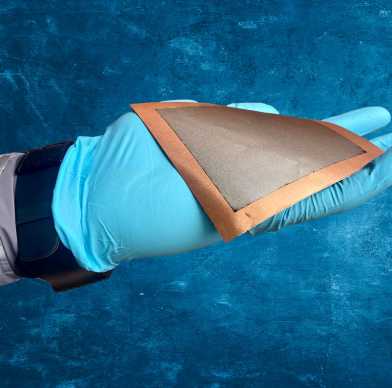
The electrification of many areas of life is leading to an increased demand for high-performance batteries. Two ETH spin-offs are making waves in this field: while BTRY develops high-performance solid-state batteries, 8inks is working on a new standard for production.
New Master’s in Space Systems to be launched in September
News

A new Master’s degree programme in Space Systems will be launched at ETH Zurich in autumn 2024. Interested parties can start applying in April.
Sound-powered sensors stand to save millions of batteries
News
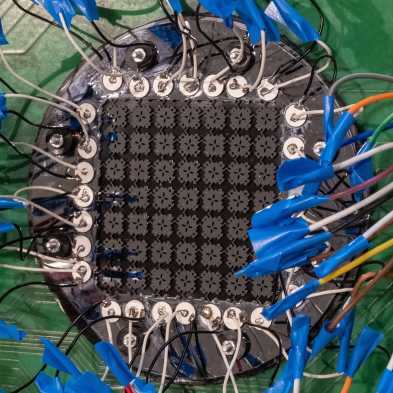
Researchers at ETH Zurich have developed a sensor that utilises energy from sound waves to control electronic devices. This could one day save millions of batteries.
Two projects launched to connect error-corrected qubits
News

ETH Zurich is participating in two quantum computing projects that are being financed by IARPA, the US research funding agency, with up to 40 million dollars. Both projects aim to connect two error-corrected qubits with one another and thus lay the foundation for future quantum computers.
Through the Australian outback in a self-built solar car
News
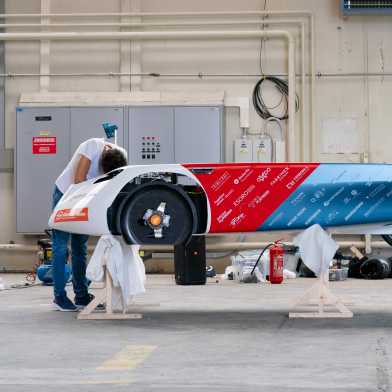
For the first time, a team of students from ETH Zurich is taking part in the renowned World Solar Challenge. Will they be able to keep up with the world’s best?
An unexpected antenna for nanoscale light sources
News
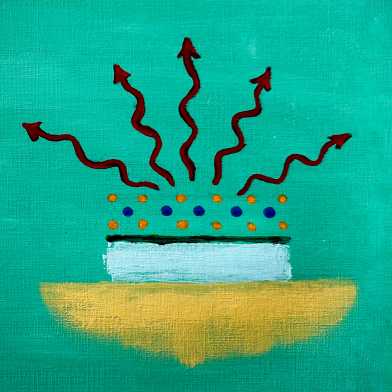
Researchers at ETH have created an antenna for light sources on a chip using an unusual placement of a semiconductor material. In the future, efficient nanoscale LEDs and lasers could be produced in this way.
Lasers enable internet backbone via satellite
News
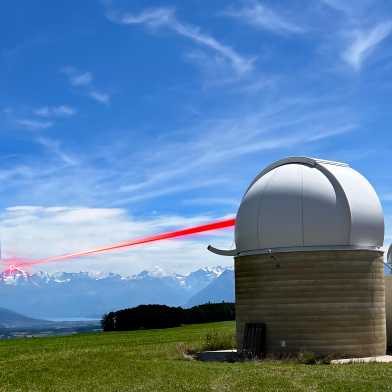
Optical data communications lasers can transmit several tens of terabits per second, despite a huge amount of disruptive air turbulence. ETH Zurich scientists and their European partners demonstrated this capacity with lasers between the mountain peak, Jungfraujoch, and the city of Bern in Switzerland. This will soon eliminate the necessity of expensive deep-sea cables.
Innovative flow batteries
- Globe magazine
- Homehero
- News

The start-up Unbound Potential has developed a new battery technology for long-duration energy storage – and received a grant of one million euros for it.
"Morph Tales" - a new ETH game invites you to get to know AI research
- Homehero
- News

The Morphs are here! The smart, eager-to-learn creatures are now waiting in the ETH main building for players to train them. "Morph Tales - Exploring Artificial Intelligence" is a new game from ETH Zurich that is fun to play and shows how humans and AI master tasks together.
Energy security in a climate-neutral Switzerland is possible
- News
- Homepage
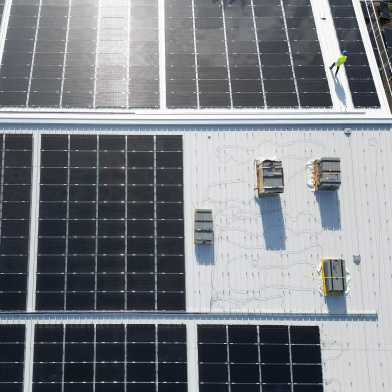
Security of energy supply in a fossil-free Switzerland is feasible and affordable according to a new white paper from an expert group at the Energy Science Center. It will require increased production of renewables and efficient energy trading with neighbouring countries.
Student-made sensor facilitates climate-conscious design of public squares
- News
- Homepage

ETH students have developed sensors that can indicate how people use urban spaces. They anonymously measure how people use objects such as chairs in a public square. The sensors have proven useful in the test run and could be used in future to plan public spaces based on needs.
Watching the metabolism at work
News
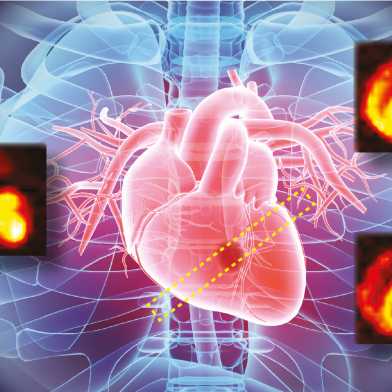
Researchers from ETH Zurich and the University of Zurich are taking magnetic resonance imaging a step further. With their new method, they can visualise metabolic processes in the body. Their objective is to improve the future diagnosis and treatment of heart disease.
The e-Sling electric aircraft takes off
News
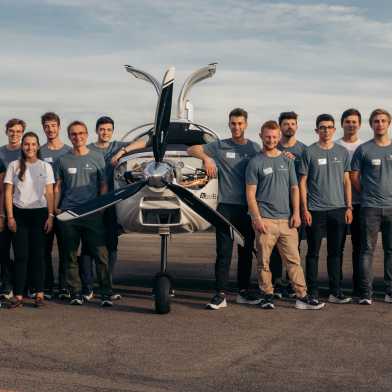
The four-seater electric aircraft “e-Sling”, which was developed by ETH students, has taken flight for the first time. The student project has taken two years and a lot of dedication.
Female stem pioneer
- News
- Globe magazine
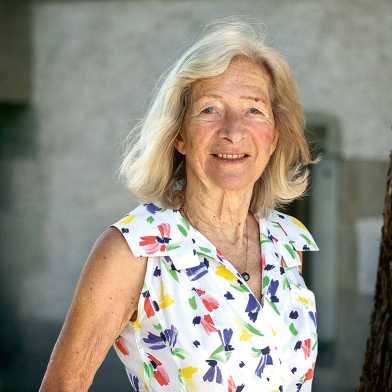
Wera Hotz Kowner was the first woman to study electrical engineering at ETH Zurich. Successfully rising above the condescension shown by some of her professors, she focused on preparing herself for her new job as managing director of the family business.
Getting into the air
- News
- Globe magazine
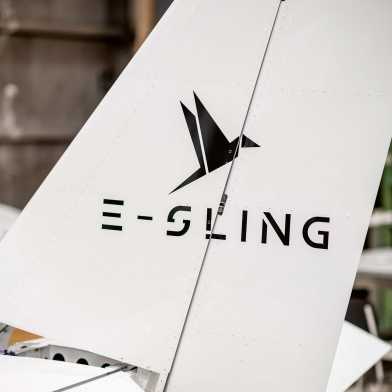
Eight ETH students are working on battery and hydrogen versions of an electric aircraft as part of the e-Sling focus project. For the past year, their lives have revolved around Hangar 3 at the Innovation Park Zurich in Dübendorf.
Colour vision
- News
- Globe magazine
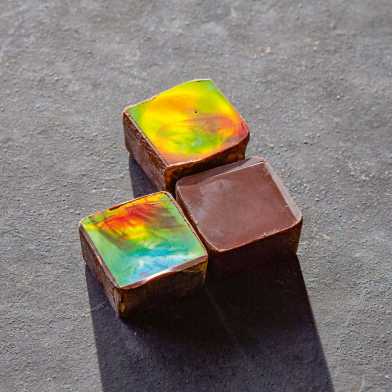
Colours can be created in surprisingly different ways. And in addition to being pleasing to the eye, colour can also serve a useful purpose.
From price shock to independence from fossil fuels
News
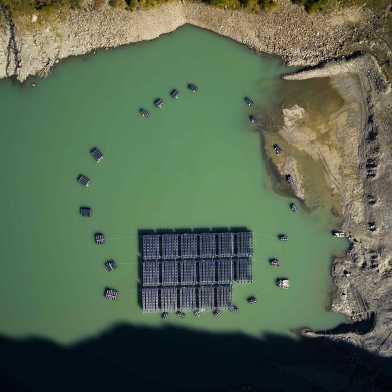
Oil and gas prices are currently on the rise, raising questions about the security of Switzerland’s energy supply. In a policy brief, researchers from the Energy Science Center at ETH Zurich have now shown what Switzerland can do to make its energy system independent of fossil fuels such as oil and natural gas.
Tunable quantum traps for excitons
News
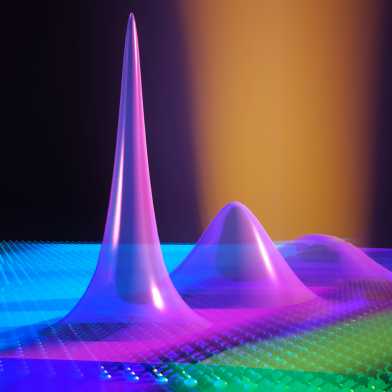
Researchers at ETH Zurich have succeeded for the first time in trapping excitons - quasiparticles consisting of negatively charged electrons and positively charged holes – in a semiconductor material using controllable electric fields. The new technique is important for creating single photon sources as well as for basic research.
Component for brain-inspired computing
News

Researchers from ETH Zurich, the University of Zurich and Empa have developed a new material for an electronic component that can be used in a wider range of applications than its predecessors. Such components will help create electronic circuits that emulate the human brain and that are more efficient at performing machine-learning tasks.
Autonomous water purification
News
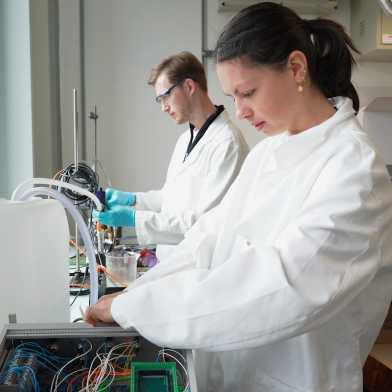
ETH News has been videoing three student teams working on focus projects. One of these is the Sowa team.
Drone and soft gripper become best friends
News
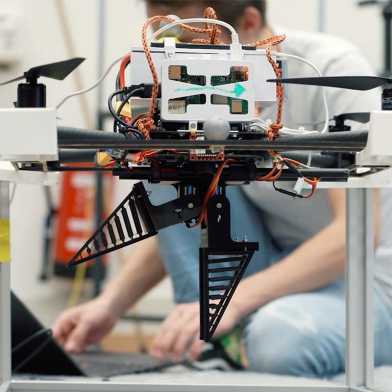
Focus projects allow mechanical and electrical engineering students to put what they have learned into practice. ETH News accompanied three student teams with a video camera – one of which was the “Raptor” team.
Are these the last ERC grants for ETH?
Press release
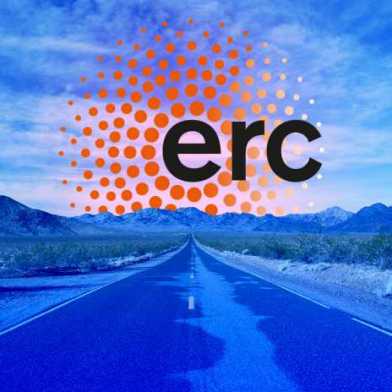
In the last application process for the sought-after ERC Starting Grants, the European Research Council made 11 awards to ETH researchers worth about CHF 17 million. Due to Switzerland’s non-association, however, the researchers will not receive these grants. The funds will now be provided by the State Secretariat for Education, Research and Innovation (SERI).
Charging electric vehicles with photovoltaics at home
News
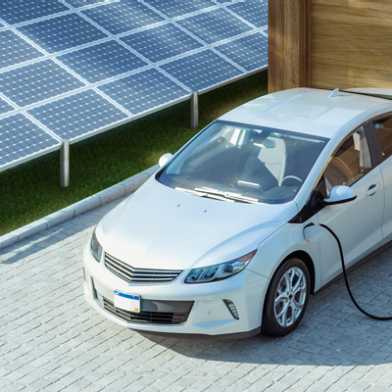
An electric car that runs on PV power sounds appealing. But is it really possible to enjoy flexibility with a vehicle charged through a home photovoltaic system? An ETH research team has reached some surprising conclusions.
Improving quality through artificial intelligence
News
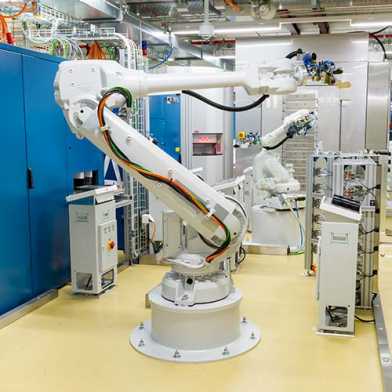
ETH researchers are using artificial intelligence to improve quality management in digital production processes. The team has succeeded in halving the proportion of defective products in an experiment with the semiconductor manufacturer Hitachi Energy.
Batteries for transporting mobility into the future
News

High-performance batteries are key to the comprehensive roll-out of e-mobility. ETH Pioneer Fellow Paul Baade is looking into how to manufacture them more cost-effectively.
A promising breakthrough: Nanocrystals made of amalgam
News
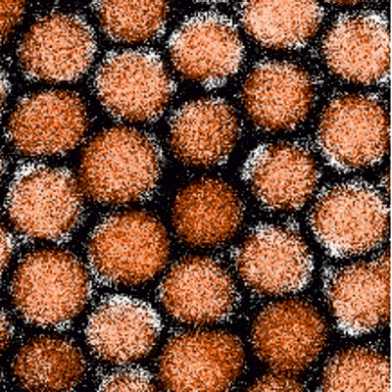
Researchers at ETH have managed to produce nanocrystals made of two different metals using an amalgamation process whereby a liquid metal penetrates a solid one. This new and surprisingly intuitive technique makes it possible to produce a vast array of intermetallic nanocrystals with tailored properties for diverse applications.
ETH students develop new solutions for the future
News
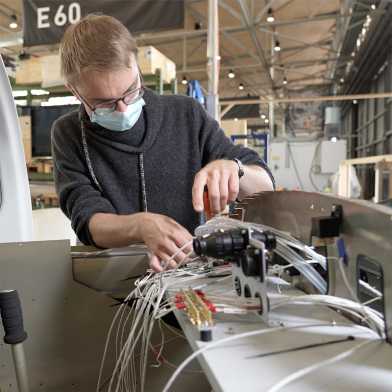
As part of the focus projects, mechanical and electrical engineering students have developed solutions for the challenges of the future. In teams, they spent two semesters developing new technical approaches for their respective projects. The “IGNIS” and “e-Sling” teams presented here are just two of this year’s many notable focus projects.
A deep dive into the brain
News
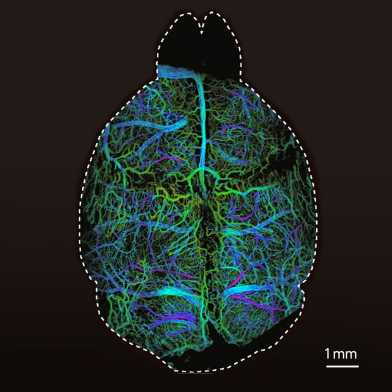
Researchers from ETH Zurich and University of Zurich have developed a new microscopy technique that lights up the brain with high resolution imagery. This allows neuroscientists to study brain functions and ailments more closely and non-invasively.
German-speaking Switzerland less critical of 5G expansion
News

The 5G wireless standard is a less polarising issue among the Swiss population than thought. According to a survey conducted by ETH researchers, the majority of people are in favour of 5G. However, a substantial portion of the population in the French-speaking region had concerns about electromagnetic radiation.
ETH Zurich and PSI found Quantum Computing Hub
Press release

ETH Zurich and the Paul Scherrer Institute (PSI) establish a joint centre for the development of quantum computers. Its aim is to advance the realization of quantum computers based on both ion traps and superconducting components. ETH Zurich provides 32 million francs for this centre, which will host around 30 researchers.
The human body as a power plant
News

The technology developed by the ETH spin-off Mithras Technology wouldn’t be out of place in a science fiction movie: the user’s own body heat powers what is known as a thermoelectric generator to charge wearables and other electronic devices.
Raising the profile of quantum research
News

Quantum research has long since ceased to be an exclusive domain of physics. The purpose of the new ETH Quantum Center is to ensure ETH Zurich’s various competences and activities in this area are networked even more closely and to raise their public profile.
Magic Cube: bringing electrical engineering to life
News
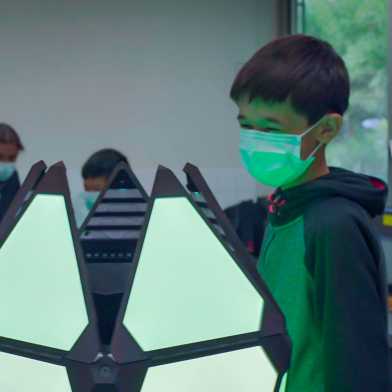
Magic Cube is a new teaching tool developed by ETH Zurich, ABB and mint & pepper. It uses a playful approach to teach junior high and high school students the basics of electrical engineering and awaken their interest in the field.
Recording thousands of nerve cell impulses at high resolution
News
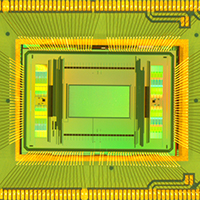
ETH researchers have developed a new generation of microelectrode-array chips for measuring nerve impulses, enabling studies of how thousands of nerve cells interact with each other.
Microelectronics shed light on neural behaviour
News

Researchers at ETH Zurich – in collaboration with colleagues from EPFL in Lausanne and Harvard Medical School – have developed a system that allows them to optically stimulate individual nerve fibres in living mice. Through this process, they have demonstrated that the nervous system has a direct influence on the immune system.
Speeding out of lockdown
News
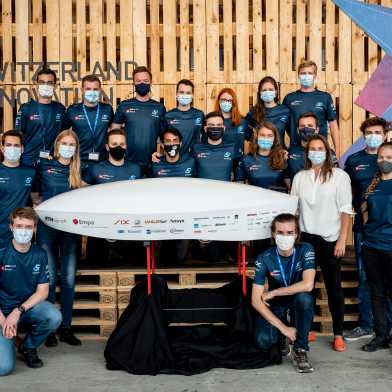
Swissloop, the team of students developing hyperloop pods, took advantage of the break imposed by the coronavirus to improve the technology even further. Yesterday they unveiled their “research pod”. At its core lies a technologically refined linear motor that will propel future prototypes at even faster speeds.
A completely new plasmonic chip for ultrafast data transmission using light
News

ETH researchers have built an ultrafast chip that can speed up data transmission in fibre optic networks. The chip combines several innovations at the same time and, given the growing demand for streaming and online services, represents a significant development.
A new theory for Semiconductors made of nanocrystals
News
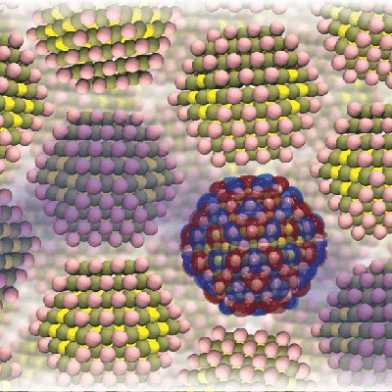
Researchers at ETH have provided the first theoretical explanation for how electrical current is conducted in semiconductors made of nanocrystals. In the future, this could lead to the development of new sensors, lasers or LEDs for TV screens.
Wavy surfaces for better light control
News
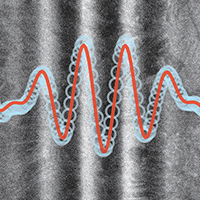
Researchers at ETH Zurich have developed a method for the production of wavy surfaces with nanometre precision. In the future this method could be used, for instance, to make optical components for data transmission on the internet even more efficient and compact.
Experiments in the kitchen and architectural models in the sandpit
News
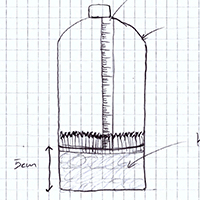
What happens when COVID-19 means architecture students have to get by without a workshop, electrical engineers without high-voltage laboratories and environmental scientists without field trips.
A fast light detector made of two-dimensional materials
News

Two research groups at ETH Zurich have joined forces to develop a novel light detector. It consists of two-dimensional layers of different materials that are coupled to a silicon optical waveguide. In the future, this approach can also be used to make LEDs and optical modulators.
From rocket builders to tree planters
News
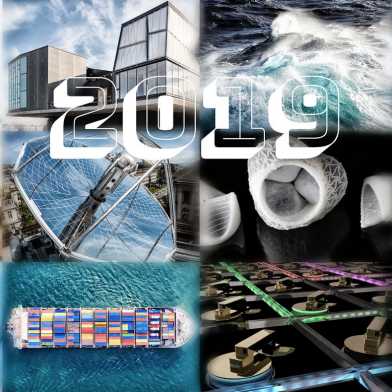
The year 2019 has certainly been a busy one at ETH. A new president took office and the second Sci-Tech Oscar was awarded, along with other major prizes, but there were also plenty of inventions and topics for discussion.
Three new National Centres of Competence in Research for ETH
News
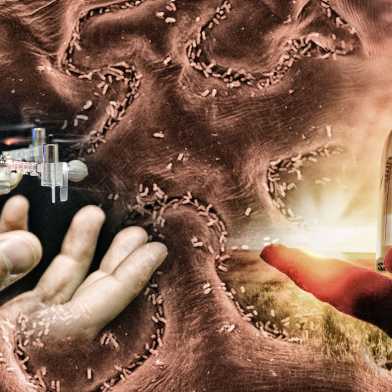
Automation and digitisation of industry and society, new approaches to sustainable chemistry, and the influence of bacteria on health – these are the topics covered by the three new National Centres of Competence led or co-led by ETH Zurich.
A “simulation booster” for nanoelectronics
News

Two research groups from ETH Zurich have developed a method that can simulate nanoelectronics devices and their properties realistically, quickly and efficiently. This offers a ray of hope for the industry and data centre operators alike, both of which are struggling with the (over)heating that comes with increasingly small and powerful transistors.
A super-fast “light switch” for future cars and computers
News
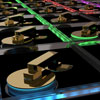
Switching light beams quickly is important in many technological applications. Researchers at ETH have now developed an “electro-opto-mechanical” switch for light beams that is considerably smaller and faster than current models. This is relevant for applications such as self-driving cars and optical quantum technologies.
Deep learning, prefabricated
News

Self-driving cars, the automatic detection of cancer cells, online translation: deep learning makes it all possible. The ETH spin-off Mirage Technologies has developed a deep learning platform that aims to help start-ups and companies more quickly develop and optimise their products.
Monitoring the Matterhorn with millions of data points
News

A unique project is linking in-situ measurements with natural hazards research. For the past ten years, a network of wireless sensors on the Matterhorn’s Hörnli ridge has been constantly streaming measurement data on the condition of steep rock faces, permafrost and prevailing climate. The project leader, Jan Beutel, reviews progress to date.
Eight students take the plunge
News
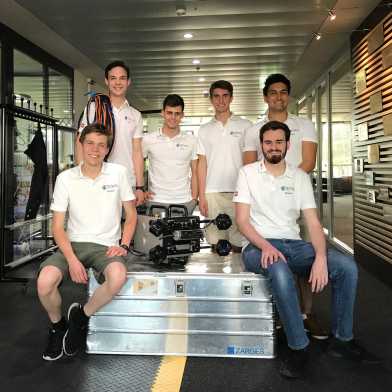
An ETH student became fascinated by diving robots while writing his Matura paper. Three years on, with a group of like-minded enthusiasts, he is taking part in one of the largest competitions for underwater robots – the first team ever from Switzerland.
Cooling with light
News
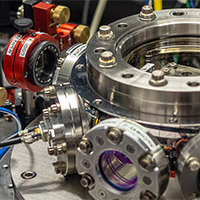
ETH researchers have cooled a nanoparticle to a record low temperature, thanks to a sophisticated experimental set-up that uses scattered laser light for cooling.
An award-winning water filter
News
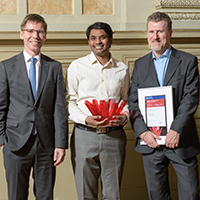
Raffaele Mezzenga, Sreenath Bolisetty and Qingrui Zhang have been awarded the Spark Award 2019 for their filter, which removes harmful fluoride from drinking water. Their invention gives people all over the world access to clean drinking water.
Data transfer by controlled noise
News

In information technology, multiplexing schemes are used to transmit more signals than the number of available transmission channels. Researchers at ETH in Zurich have invented a novel method whereby information is encoded in the correlated noise between spatially separated light waves.
Of autonomous duck taxis and a precise Mars landing
News
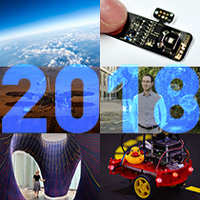
ETH technology that flew to Mars, rubber duckies that travelled around Duckietown in self-driving taxis and moles that warn of tumours – for ETH, 2018 was marked by innovative flair and extraordinary research. We take a look back.
Millimetre waves for the last mile
News
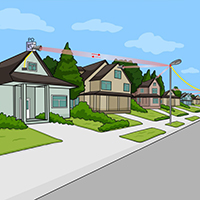
Reseachers at ETH Zurich have developed a modulator with which data transmitted via millimetre waves can be directly converted into light pulses for optical fibres. This could make covering the “last mile” up to the internet socket at home considerably faster and cheaper.
Smart transformer for the energy turnaround
News
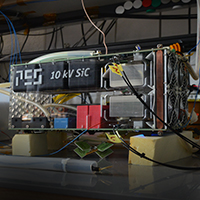
A new, smart medium-voltage transformer developed at ETH Zurich features cutting-edge semiconductor technology, making it extremely compact and energy efficient. Future applications are ranging from locomotives to fast charging stations for electric vehicles and from power supplies for data centres to use in future power grids.
Computational mathematician honoured
News
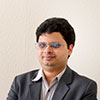
Siddhartha Mishra is the winner of the 2019 ICIAM Collatz Prize which is one of the most prestigious prizes awarded in applied mathematics.
Swissloop misses top three
News
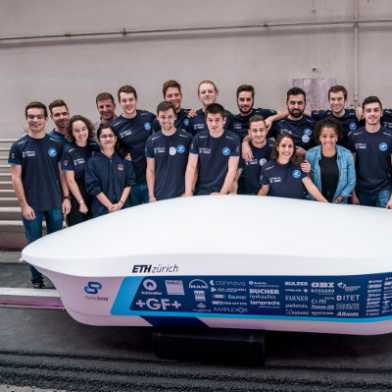
The third Hyperloop Pod Competition in LA saw Swissloop compete against teams from all over the world. Due to a short-circuit, their pod didn't make it into the top three.
InSight mission to Mars lifts off successfully
News
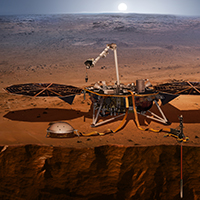
The Atlas V rocket with the NASA InSight spacecraft left California on Saturday, May 5th, heading for Mars. The spacecraft is carrying a seismometer built with electronics developed at ETH Zurich, and for the first time, it will fly the Swiss flag and ETH logo to the red planet. The seismometer is designed to record seismic waves produced from marsquakes, that will allow scientists to explore the interior of Mars.
“Maybe it’s to do with the type of person”
News
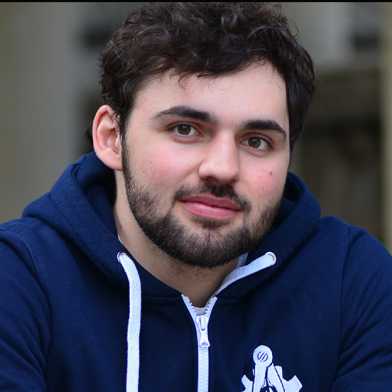
AMIV, the association for mechanical and electrical engineering students, is celebrating its 125th anniversary next week. ETH News used the occasion to speak to AMIV’s president Aurel Neff about its successes and challenges.
Award-winning artificial intestinal flora
News
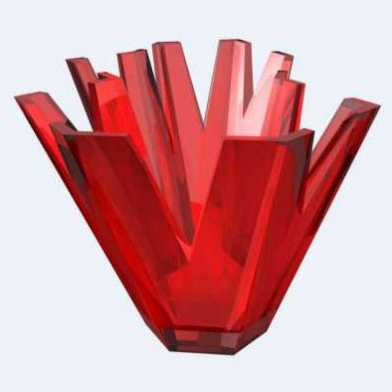
A research team led by microbiologist Tomas de Wouters has won the Spark Award 2018 for the development of artificial intestinal flora. With their ETH spin-off Pharmabiome, the scientists want to further develop their invention so that it can be used in the treatment of inflammatory intestinal diseases and infections.
A receiver for touch communication
News
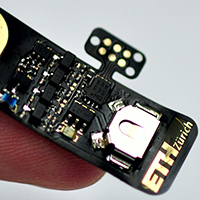
Battery lifetime is an important issue in wearable devices. Ideally, they should always be ready to receive control signals without consuming a lot of power. Researchers at ETH Zurich have now developed a zero-power receiver for touch communication that harvests its energy directly from the signal.
Making the cable industry a little sexier
News
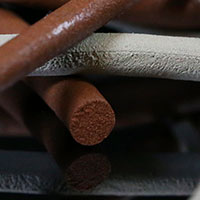
ETH engineers Vincent Martinez and Luca Hirt are on a mission: to make cables more durable and reliable. This could potentially lead to unbreakable headphone cables, shaking up an industry known for its slow pace of innovation.
Electronic pills of the future
Zukunftsblog
Martin Fussenegger is convinced that the digital world in which we live will become interlinked with the biological world. He envisages that we will be able to cure diseases with electronic pills in the next 50 years.
X-ray light revolutionaries
News
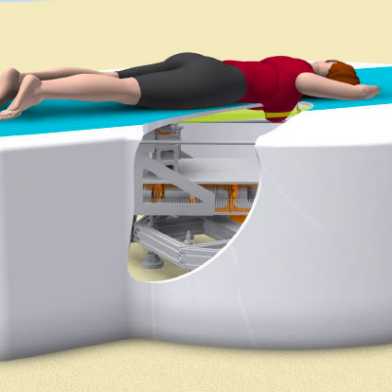
The ETH spin-off GratXray is working to improve precision in mammography. With the help of an innovative new device, breast cancer detection might not only become more accurate, but also painless. This is a revolutionary step in breast screening.
Ruzicka Prize for electricity generating materials and LEDs
News

This year the Ruzicka Prize goes to Maria Ibáñez and Chih-Jen Shih. The prize is awarded for the improved synthesis of materials that can generate electricity from waste heat and for the development of new LEDs with an unachieved color spectrum for the next generation of displays.
Optoelectronics without glass
News
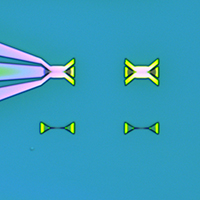
Researchers at ETH Zurich have developed the first opto-electronic circuit component that works without glass and is instead made of metal. The component, referred to as a modulator, converts electrical data signals into optical signals. It is smaller and faster than current modulators, and much easier and cheaper to make.
How songbirds learn a new song
News

As an international team of scientists has now shown, songbirds are minimalists when it comes to learning a new song. The birds’ learning strategy resembles the methods used by computer scientists for document comparison.
Biodegradable microsensors for food monitoring
News
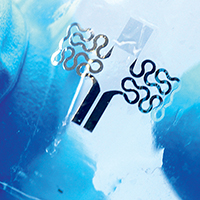
A new generation of microsensors could provide the vital link between food products and the Internet of Things. ETH researchers have developed an ultra-thin temperature sensor that is both biocompatible and biodegradable.
Holograms for molecules
News
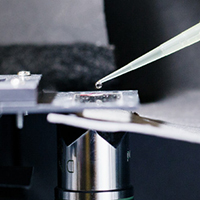
Scientists at ETH Zurich and Roche have developed a completely new method for the analysis of molecules in liquids on a chip. The possible applications of this technology are immense. It has the potential, inter alia, to revolutionise medical diagnostics.
Rapid imaging of granular matter
News
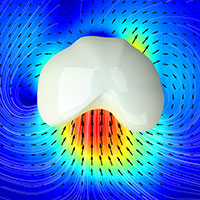
Granular systems such as gravel or powders can be found everywhere, but studying them is not easy. Researchers at ETH Zurich have now developed a method by which pictures of the inside of granular systems can be taken ten thousand times faster than before.
12 million for research into atomic-scale components
Press release
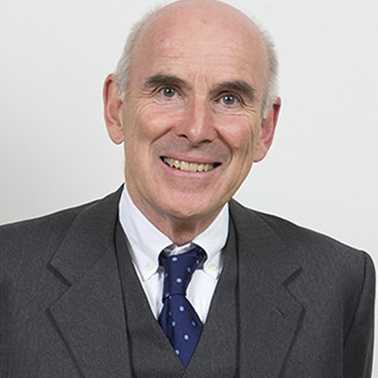
The Werner Siemens-Foundation has donated CHF 12 million to establish the Centre for Single-Atom Electronics and Photonics. ETH Zurich and the Karlsruhe Institute of Technology (KIT) are establishing the centre to develop new types of integrated circuits for communications networks.
CO2-free mobility: (how) is that possible?
Zukunftsblog

Right now, everyone is talking about mobility, how it ought to be CO2-neutral and clean. Yet how do we get there? Banning combustion engines, changing how we usually get around or gradually shifting towards electric vehicles – the ideal path is not exactly clear.
From Zurich to Berlin in 35 minutes
News

Fifty students from ETH Zurich and other Swiss universities want to revolutionise transport. For a race set up by Elon Musk, they have developed a zero emission capsule that could in future transport people and goods through a vacuum tube at almost the speed of sound.
More security in cyberspace
News

At yesterday's Cyber Risks Summit at ETH Zurich, international experts discussed and presented the latest scientific and technological approaches for effectively protecting society from the dangers of cyberspace.
High voltage for tomorrow's particle accelerator
News
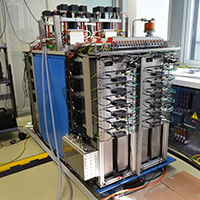
On behalf of CERN, researchers at ETH Zurich have developed a high-tech device for the production of extremely precise, high voltage pulses that could be used in the next generation of particle accelerators.
How does trust work on the internet?
News

A secure and reliable internet generates trust. Just how the internet creates trust is a matter for debate between ETH computer scientists and social scientists – for example, in a public session on 9 May 2017.
A high-speed motor for satellites
News
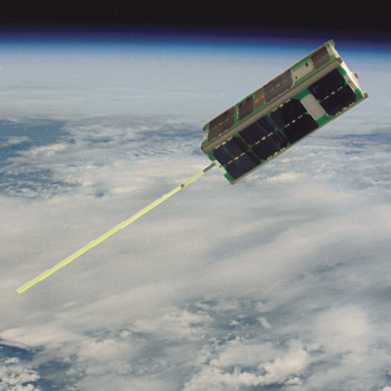
A dizzying 150,000 revolutions per minute: researchers from ETH Zurich (Department of Information Technology and Electrical Engineering) and the ETH spin-off Celeroton have developed an ultra-fast magnetically levitated electric motor for reaction wheels. The high speed of rotation allows intensive miniaturisation of the drive system, making it attractive for use in small satellites.
Net-worker with the drive to optimise
News
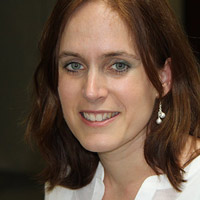
She connects electricity networks and people: Gabriela Hug is Professor of Electric Power Systems – and a sought-after woman. Her research helps make existing electricity infrastructure fit for the energy transition.
Nanowalls for smartphones
News
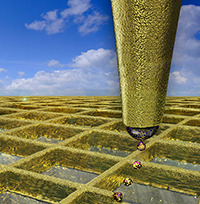
Researchers at ETH Zurich have manufactured transparent electrodes for use in touchscreens using a novel nanoprinting process. The new electrodes are some of the most transparent and conductive that have ever been developed.
Smaller, faster, cheaper
News
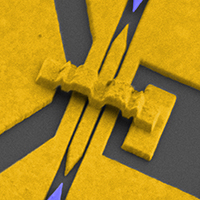
Transmitting large amounts of data, such as those needed to keep the internet running, requires high-performance modulators that turn electric signals into light signals. Researchers at ETH Zurich have now developed a modulator that is a hundred times smaller than conventional models.
Europa baut bei den Erneuerbaren eine führende Rolle auf
Zukunftsblog
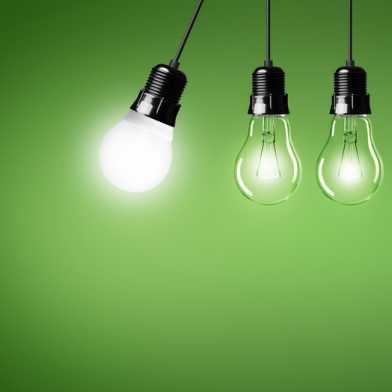
Dänemark, Spanien und Portugal gelten als Pioniere der erneuerbaren Energie. Sie speisen heute weit mehr Sonnen- und Windenergie in ihre Stromnetze ein als jemals erwartet und zeigen so, dass eine Energiewende unabhängig von der geografischen Lage möglich ist. Europa hat künftig die Chance, seine Vorreiterrolle weiter auszubauen.
Buckle up for fast ionic conduction
News
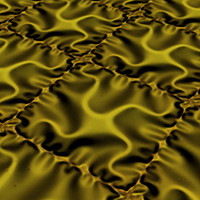
ETH material engineers found that the performance of ion-conducting ceramic membranes that are so important in industry depends largely on their strain and buckling profiles. For the first time, scientists can now selectively manipulate the buckling profile, and thus the physical properties, allowing new technical applications of these membranes.
12 professors at ETH Zurich appointed
News

At its meeting of 20/21 March 2015, the ETH Board appointed 12 professors at ETH Zurich in accordance with the application submitted by ETH President Lino Guzzella.
Nanoelectronics on the “computer test bench”
News
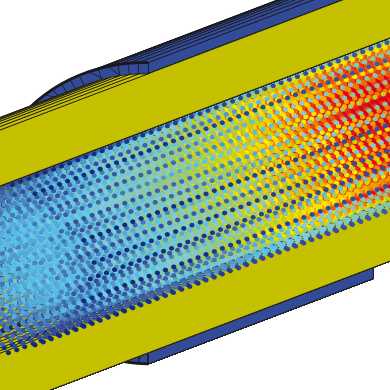
Thanks to a special computer programme, researchers from ETH Zurich are able to simulate electronic nanocomponents and help materials science and industry in the development and production process.
From tobacco to cyberwood
News
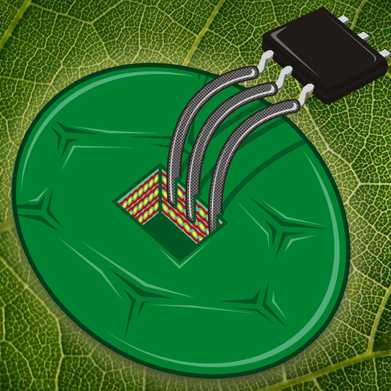
Scientists from ETH Zurich have developed a thermometer that is at least 100 times more sensitive than previous temperature sensors. It consists of a bio-synthetic hybrid material of tobacco cells and nanotubes.
ScopeM: Magnifying the minuscule
News
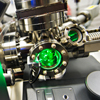
Need an optical or electron microscope for your research? Look no further than ScopeM. The Hönggerberg campus has been home to this technology platform since 2014.
Sparen Computer Energie?
Zukunftsblog
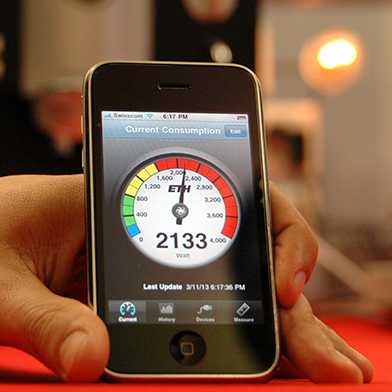
Computer und Kommunikationsnetze benötigen Strom; sie sind für ein bis zwei Prozent des Weltenergieverbrauchs verantwortlich. Andererseits wird mit ihrer Hilfe Energie in anderen Bereichen eingespart, wobei die «smarte» Informationstechnik zunehmend an Bedeutung gewinnt.
Voltage tester for beating cardiac cells
News
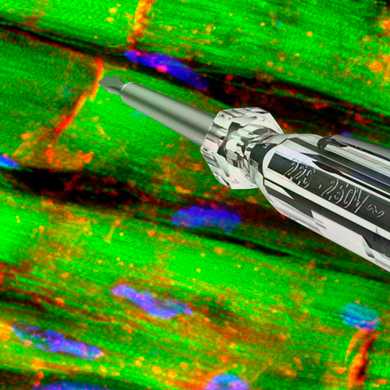
For the first time, scientists have succeeded in recording the current in membrane channels of contracting cardiac cells. To do this, the scientists combined an atomic force microscope with a widely used method for measuring electrical signals in cells.
Demystifying nanocrystal solar cells
News
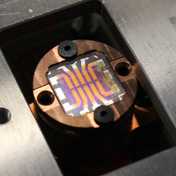
ETH researchers have developed a comprehensive model to explain how electrons flow inside new types of solar cells made of tiny crystals. The model allows for a better understanding of such cells and may help to increase their efficiency.
Sensors take the tram
News
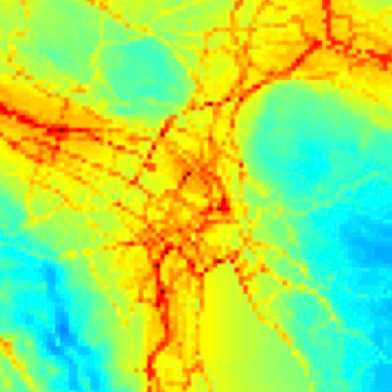
For almost two years, researchers at ETH Zurich have been measuring air quality along tram lines in Zurich. They have now presented maps that for the first time show precisely when and where air pollution in Zurich is at its highest.